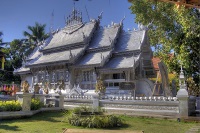
Chiang Mai is Thailand's second largest city, and an excellent starting point for excursions into the northern territories. Its name means 'new city', even though Chiang Mai is much older than Bangkok, having been built in 1296 under the rule of King Mengrai. The city straddles the gap between urban and rural Thailand, and offers the best of both worlds in terms of attractions and activities for Thailand tourists.
While Chiang Mai has more than 300 ancient temples, including the one at Doi Suthep, which offer breathtaking views over the area, its popularity is largely due to the elephant treks in the surrounding countryside. Travellers can also use Chiang Mai as a launching pad for excursions to the Lisu Hill-Tribe, Bhubing Palace, Isaan province, and Chiang Rai. Thai cookery classes are also a popular tradition, and the city also has an extensive night market, with dozens of street vendors selling a variety of traditional Thai wares that can be obtained at very low prices if travellers have the patience to bargain for them.
Chiang Mai is small enough to get around on a bicycle, has several attractions, and offers excellent accommodation, although tourists are advised that it can be difficult to find a room in peak season, between December and March.

01474 814411

Travel Guide powered by Word Travels, copyright © 2023 Globe Media Ltd. By its very nature information in this travel guide is subject to change at short notice and travellers are urged to verify information on which they're relying with the relevant authorities. Neither Globe Media Ltd nor Travel Vogue can accept any responsibility for any loss or inconvenience to any person as a result of information contained above.